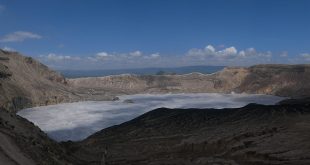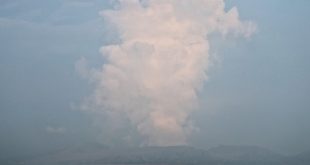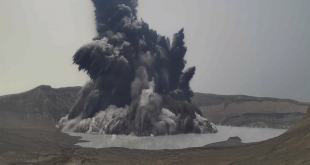Matapos ang higit sa dalawang buwan pag iintay matapos magkaroon ng phreatic explosion ang bulkang taal. Ibinaba na ng Philvocs ang alert level ng bulkan sa alert level 1 nitong March 19, 2020.
Tingnan ang buong Taal Volcano Bulletin:
TAAL VOLCANO BULLETIN
19 March 2020
8:00 AM
This serves as a notice for the lowering of Taal Volcano’s status from Alert Level 2 (Decreased Unrest) to Alert Level 1 (Abnormal).
Taal Volcano’s condition in the succeeding four (4) weeks after step-down to Alert Level 2 on 14 February 2020 has been characterized by low-level volcanic earthquake activity, stabilizing ground deformation of the Taal Caldera and Taal Volcano Island (TVI) edifices and weak surface activity at the Main Crater and the Daang Kastila fissure. These observations are supported by the following monitoring parameters:
1. The Taal Volcano Network (TVN) recorded a decline in the daily average of volcanic earthquakes from 141 events/day between 26 January and 14 February to 31 events/day between 14 February and today. The majority of these earthquakes are associated with rock-fracturing processes and only six (6) low frequency events associated with magmatic or hydrothermal activity were detected until 6 March. These parameters are consistent with degassing ponded magma rather than active magma transport to and from the shallow magma reservoir beneath TVI.
2. Continuous Global Positioning System (GPS) monitoring from 14 February to 16 March recorded very slow and slight uplift of the northern sector of Taal Caldera but continuing subsidence of the southern sector of the caldera and southern TVI. Such motions describe the overall ground deformation behavior of Taal Volcano since 13 January and are broadly consistent with post-eruptive relaxation of the Taal edifice.
3. Sulfur dioxide or SO2 flux based on Flyspec campaign averaged 56 tonnes/day between 14 and 17 February before falling below detection limits in the succeeding days. Such low concentrations are consistent with a weakly degassing shallow magma source and absorption or “scrubbing” of volcanic gas by a recovering lake within the Main Crater and by TVI’s recovering hydrothermal system.
4. Surface activity has abated to weak emission of 50-100-meter tall steam-laden plumes from fumaroles or active gas vents on the Main Crater and along the Daang Kastila fissure on the northern flank of TVI. The last significant activity from the Main Crater occurred on 26-27 February and generated 300-meter tall steam-laden plumes for six hours. Since then, background fumarolic activity and the regrowth of the Main Crater Lake have been quietly transpiring.
In view of the above, DOST-PHIVOLCS is lowering the alert status of Taal Volcano from Alert Level 2 to Alert Level 1 to reflect the overall decreasing trend in the level of monitoring parameters. Alert Level 1 means that the volcano is still in abnormal condition and should not be interpreted that unrest has ceased or that the threat of an eruption has disappeared. Should an uptrend or pronounced change in monitored parameters forewarn of renewed unrest, the Alert Level may be raised back to Alert Level 2. Residents of areas at high risk to base surges who have returned after the step-down to Alert Level 2 on 14 February must therefore remain vigilant and always prepared for a quick and organized evacuation. Conversely, should there be a return of monitoring parameters to baseline levels after a sufficient observation period, the Alert Level will be further lowered to Alert Level 0.
DOST-PHIVOLCS reminds the public that at Alert Level 1, sudden steam-driven or phreatic explosions, volcanic earthquakes, minor ashfall and lethal accumulations or expulsions of volcanic gas can occur and threaten areas within TVI. DOST-PHIVOLCS strongly recommends that entry into TVI, Taal’s Permanent Danger Zone or PDZ, especially the vicinities of the Main Crater and the Daang Kastila fissure, must remain strictly prohibited. Local government units are advised to continuously assess previously evacuated barangays around Taal Lake for damages and road accessibilities and to strengthen preparedness, contingency and communication measures in case of renewed unrest. People are also advised to observe precautions due to ground displacement across fissures, possible ashfall and minor earthquakes. Civil aviation authorities must advise pilots to avoid flying close to the volcano as airborne ash and ballistic fragments from sudden explosions and wind-remobilized ash may pose hazards to aircrafts.
DOST-PHIVOLCS is closely monitoring Taal Volcano’s activity and any new significant development will be immediately communicated to all stakeholders.
 WOWBatangas.com Your Source of Great News and Stories from the Province of Batangas, Philippines
WOWBatangas.com Your Source of Great News and Stories from the Province of Batangas, Philippines



